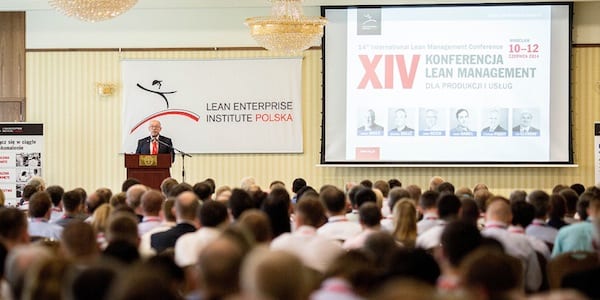
The gift that keeps on giving
FEATURE – The benefits of establishing a lean operating system will support the growth and success of a business in the long term, says Karen Gaudet looking back at her experience at Starbucks.
Words: Karen Gaudet, Team Leader Operations & Personnel, Lean Enterprise Institute
Our lean efforts at Starbucks began with the introduction of set of standardized work routines focused on bringing consistency to the way we were brewing coffee to ensure that we had the right beverage for the customer at the right time (while also limiting the amount of coffee we threw away).
Over time, that same approach expanded to all the different types of work occurring inside of the cafe, from espresso beverage making to ringing people through the registers, from warming and dispensing pastries to replenishing the ingredients needed in the different workstations.
Eventually, these independent routines became a system in and of itself – we called it the “Playbook” – which gave us all (from baristas to leaders) an intimate understanding of the work that was needed in each one of those areas to meet customer demand. It put us all on the same page and allowed us to engage in very effective conversations around the problems we experienced in the work.
As leaders, we were now in a position to understand the details of the work taking place in each one of the cafes and all the levers necessary to develop our people and drive the business forward. The lean system we established gave us the opportunity to functionally talk about the impact of our decisions on the actual operation.
In a corporate organization like Starbucks, which develops its strategy around new products, this lean operating system based around serving the customer as effectively as possible made it much easier and faster to determine how a product was going to perform and what we needed to do to ensure that it would perform well. The simple act of a customer walking into a cafe and ordering their breakfast began to reverberate all the way through the system: someone was going to have to ring up that customer, someone else was going to have to brew their coffee, someone else was going to have to assemble that sandwich, warm it up and serve it. Every individual “touching” that order and transaction was now engaged, and we all shared an intimate understanding of the work of those individuals. There was a high level of business acumen and awareness of the mechanics of the work, which were no longer elusive (this is particularly important in a fast environment where staffing challenges are real and ever-changing).
By knowing the details of the work, we were able to stabilize the process and understand a customer's order in a very different way – as well as the problems that might arise in fulfilling that order. I remember a specific issue in one of our cafés, where due to space constraints the warming oven had been placed around 100 feet away from the pastry case. Thanks to the lean operating system and the knowledge that comes with it, the team was able to come up with a solution: sending a signal down the line, all the way to the Espresso bar, that a breakfast sandwich had to be prepared (in the same way that a beverage was ordered), instead of handing it off to the register person. This way, the team was able to reduce the amount of movement behind the counter and to speed up service.
Improvements like this proved that front-line people now understood the business at a much greater level than before and were empowered to improve (and why not, innovate) at a much faster pace. Business leader, on their part, developed a very clear understanding of the way the business operated and of the capabilities people needed to solve problems like the one with the oven.
TO THE MACRO, VIA THE MICRO
The establishment of a lean operating system enables you to focus in on the micro details necessary to get traction on your improvements, so that you can think at a macro level more easily. It often feels overwhelming to think about large organizational problems and what it takes for a leader to effect change across the entire system: with a lean operating system in place, you will learn to analyze the micro to understand the macro.
By adopting this stance, leaders become a greater value asset to the organization: they will be more effective and productive in the problem-solving process and they will be able to not only think and plan strategically around the whole enterprise, but also zoom in on the micro level to help lead those that are going to improve the details of the work and innovate.
In my mind, understanding this “micro-to-macro” dynamic is fundamental. It’s frustrating to see so many individuals and teams out there grow impatient (and often disillusioned) after realizing that their improvements are not taking off. As a result, they often get burned out and abandon their lean efforts altogether, when they are just about to break through to system-level change. A lean transformation works much like a snowball rolling downhill: it doesn't really get big until it gets closer to the bottom.
System change stems from small, incremental improvement. As I discussed in a previous article for Planet Lean, that’s where the strategic relationships between key functions become pivotal in supporting the front line to improve the work and ensuring this improvement is recognized as impactful for the business as a whole. This is critical to keep people engaged and the momentum going. I see so many organizations that are struggling to work through a transformation because they don’t have the support of the Finance or HR teams. And mind you, it's not about leaning those functions out; it's about those functions learning about the transformational work that's occurring in the day-to-day operations so that they can reinvent their roles in service to that improvement.
A DIFFERENT VIEWPOINT
Lean Thinking is a long-term commitment and requires a dramatic shift in our mindsets. At Starbucks, especially in the early years (prior to 2008, when the company was growing incredibly fast), the prevalent mentality was focused on ROI. Whether it was launching a new product or building out a new store, we’d expect to see the fruits of our investment within the first year. What the lean operating system brought to light was that lean benefits have a way to return over time.
Lean is a continuous investment. It takes time to bring change about and sustain it, to get people on board and develop their capabilities to transform the business, which is why a financial model informed by Lean Thinking is based on an internal rate of return, rather than on return on investment. Indeed, effecting lean change means not only to fix the problem we have in front of us right now, but also see the next set of problems that need to get addressed in order to connect effectively to the next part of the system.
I would go as far as saying that the improvements and the success that Starbucks continues to experience is a return on those early, transformational years when the lean team developed the lean operating system, greatly improving the work and standardizing it.
It is that same “ROI mentality” that makes it so challenging for people to embrace Lean Thinking. I think that’s why it’s so important to have the right coach supporting you, someone who can steer you in the right direction and help to prioritize problems to solve that will improve the work of the people driving the performance of the business. This can quickly demonstrate the potential of improved business results that return in the here and now and pay dividends over time.
Want to Keep Learning?

Read Steady Work by Karen Gaudet, who managed 110 stores as a regional manager for Starbucks. She offers smart, practical business advice and a heartfelt personal story about how a continuous improvement system revitalized the retailer during the global financial crisis and helped employees in Newtown, CT, get through a national tragedy.
THE AUTHOR

Read more


FEATURE – A senior executive of a Spanish hotel chain shares an example of how the organization’s management system and visual tools have changed over time.


REVIEW - Roberto Priolo reviews the 14th Lean Management Conference, held earlier this month in Poland. With great presentations and speakers, the event left him with a lot to reflect on.


INTERVIEW – At the recent Lean IT Summit, Planet Lean spoke to BlaBlaCar, a Paris-based company that has managed to keep the startup way of thinking alive in the face of the hypergrowth it experienced in the past four years.


FEATURE - The author addresses the ongoing debate on rewards and recognition, explaining how an optimal relationship between team members, team leaders and group leaders will influence motivation.

